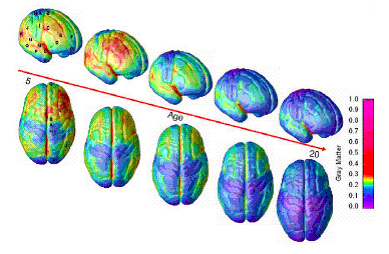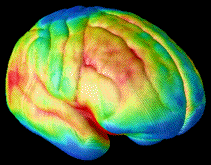For
many years it was thought that brain development was set at a fairly early age.
By the time teen years were reached the brain was thought to be largely finished.
However, scientists
doing cutting-edge research using magnetic resonance imaging, or MRI, have mapped
the brain from early childhood into to adulthood and found very contrary data.
It now appears the brain continues to change into the early 20's with the frontal
lobes, responsible for reasoning and problem solving, developing last. Get
Creative!! Can
you develop a questionnaire form to provide psychological data to support these
studies?
|  FOR TIME LAPSE
PHOTOGRAPHY
FOR TIME LAPSE
PHOTOGRAPHY
| Figure
1. Time-Lapse
Imaging Tracks Brain Maturation from ages 5 to 20 Constructed
from MRI scans of healthy children and teens, the time-lapse "movie", from which
the above images were extracted, compresses 15 years of brain development (ages
5–20) into just a few seconds. Red
indicates more gray matter, blue less gray matter. Gray matter wanes in a back-to-front
wave as the brain matures and neural connections are pruned. Source:
Paul Thompson, Ph.D. UCLA Laboratory of Neuroimaging http://www.nimh.nih.gov/press/prbrainmaturing.cfm?styleN=one |
Although
scientists don't know yet what accounts for the observed changes, they may parallel
a pruning process that occurs early in life that appears to follow the principle
of "use-it-or-lose-it:" neural connections, or synapses, that get exercised are
retained, while those that don't are lost.  | Brain
Tissue Changes in Development (15 year timespan) Time-lapse
Imaging Tracks Brain Developing from ages 5 to 20 NIMH/UCLA Project Visualizes
Maturing Brain Source:
Paul Thompson, Ph.D. UCLA Laboratory of Neuroimaging |
| Where
can you go from here? Here
is one idea---- Create
a questionnaire form to access Risk Taking.. Use
the questionnaire on 4 age groups (range from 5-20). You should have at least
10-15 subjects in each group to provide enough data. Compare
your data with changes in brain development using the data from TIME
LAPSE PHOTOGRAPHY. Further
Reading The
Adolescent Brain -- Why Teenagers Think Differently
Teen
Brains Explain Mood Swings Teen
Brains on Trial Teen
Brains Under Construction Imaging
Study Shows Brain Developing -- NIH FINAL
NOTE : DISCUSS ALL YOUR IDEAS FOR A SCIENCE PROJECT WITH YOUR TEACHER BEFORE
STARTING ONE | 
